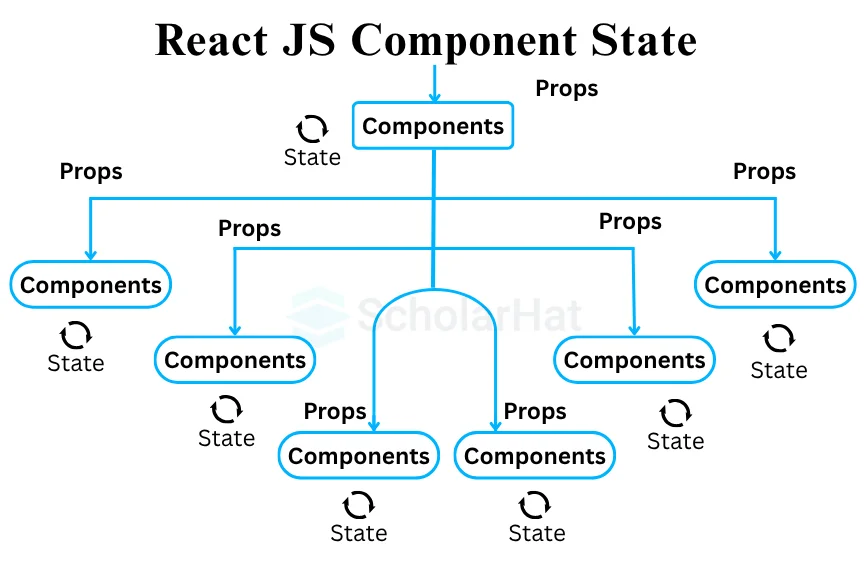26
DecMaster React JS Components: Your Guide to Building Dynamic User Interfaces
React JS components are basic building blocks of user interfaces in web applications. They are independent, reusable pieces of code that determine what appears on the user interface (UI). Components enable developers to break down complex UIs into smaller, manageable, and self-contained units, supporting modularity, reusability, and maintainability.
In this React tutorial, we’ll explore the fundamentals of React components, including what they are, the different types (functional and class-based), and how they work together to build dynamic and reusable user interfaces. 70% of front-end job listings now require React.js expertise. Don’t get left behind—join our Free React Course with Certificate and build in-demand skills!
Read More - Top 50 Most Asked React Interview Questions & Answers
What are React Components?
- React components are the basic building blocks of any React application.
- They are small, code-encapsulated units that can be utilized to build user interfaces across the entire program.
- The UI can be divided into smaller, modular components, allowing developers to create sophisticated apps more quickly and easily.
- A React component is responsible for maintaining its state and handling events while rendering a portion of the user interface.
- It can be viewed as a standalone component that receives data, processes it, and then outputs a React element that specifies what should be shown on the screen.
- The component-based architecture of React JS improves development productivity and makes it possible to create dynamic, interactive user interfaces.

Types of React Components
Functional and class components in React are the two primary types of components used in React. Render component react, Composing Components, and Decomposing Components are some additional components. Proper inputs, which components can receive, enable customization and data exchange between components.
1. Functional Components
The most basic type of React components is functional ones. In essence, they are JavaScript functions that accept the input props (short for properties) and return a React element. Because they lack an internal state, functional components in React are sometimes known as stateless components. They are the only ones in charge of rendering the user interface using the input props.
Here is a simple example of a React functional component:
import React from 'react';
function Welcome(props) {
return <h1>Welcome, {props.name}!</h1>;
}
export default Welcome;Explanation:
The code defines a functional React component called Welcome that takes props and displays a personalized message using props.name. It uses JSX to render the output and is exported for use in other files.
2. Class Component
Functional components are simpler than class components in React. They extend React. Component classes are built using ES6 classes. Class components may manage more complex logic & handle events because they have their own internal state & lifecycle methods. Class components in React contain the following essential features:
- State: It contains information that may vary over time and has an impact on how a component renders. by way of this state.
- Props: Data transmitted by a parent component. They serve as a read-only data and configuration route for child components. Accessible through this. props.
- Lifecycle Methods: Activities carried out at particular phases of the component's lifecycle. ComponentDidMount(), ComponentDidUpdate(), and ComponentWillUnmount() are a few examples.
- Event Handlers: Procedures that specify and manage events brought on by user activities. JSX-based attachments to elements, such as onClick={this.handleClick}.
- Class Methods: Additional, customized methods that are a part of the component's class and carry out the particular logic or tasks that the component requires.
- Render Method: Provides JSX code describing the structure and content of the component. When the part has to be modified, this method is called, and only one root element is returned.
Here is an example of a simple class component in React:
import React from 'react';
class MyComponent extends React.Component {
render() {
return (
<div>
<h1>Hello, World!</h1>
</div>
);
}
}Explanation:
The code defines a class-based React component called MyComponent that extends React.Component. It uses the render() method to return JSX, which displays a <div> containing an <h1> with the text "Hello, World!". The import React from 'react'; line is necessary to enable React features.
Note:
This component can be used in other files by exporting it using export default.
Read More - React developer salary
Props in React Components
Props (short for properties) are used to pass data from one component (usually a parent) to another (usually a child). They are read-only and help make components reusable and dynamic by allowing them to receive different values.
- Props are immutable inside the child component.
- They allow communication from parent to child.
- Props help create reusable UI components.
import React from 'react';
import ReactDOM from 'react-dom';
// Define a functional component
function Greeting() {
return <h1>Hello, React!</h1>;
}
// Another functional component using props
function Welcome(props) {
return <p>Hello, {props.name}! You have {props.messages} new messages.</p>;
}
// Render components
ReactDOM.render(
<div>
<Greeting />
<Welcome name="ScholarHat" messages={3} />
</div>,
document.getElementById('root')
);
Explanation:
This code imports React and ReactDOM, defines two functional components: Greeting for a static message and Welcome for a dynamic message using props. Both components are rendered inside a div and mounted to the DOM element with the ID root.
State in React Components
State in React refers to a built-in object used to store dynamic data that affects how a component behaves and renders. Unlike props, state is mutable and is managed within the component itself.
- The state holds data that can change over time.
- It is managed within the component using the useState hook (in functional components).
- Changing state triggers a re-render of the component.
- Unlike props, state is local to the component.
import React, { useState } from 'react';
import ReactDOM from 'react-dom';
// Define a functional component
function Greeting() {
return <h1>Hello, React with State!</h1>;
}
// Component with state
function MessageCounter() {
const [count, setCount] = useState(0);
return (
<div>
<p>ScholarHat has {count} new messages.</p>
<button onClick={() => setCount(count + 1)}>Add Message</button>
</div>
);
}
// Render components
ReactDOM.render(
<div>
<Greeting />
<MessageCounter />
</div>,
document.getElementById('root')
);
Explanation:
The code imports React, useState, and ReactDOM. It defines a Greeting component that displays a welcome message, and a MessageCounter component that uses state to track and display the number of messages. Clicking the button increases the count. Both components are rendered inside a <div> and attached to the DOM using ReactDOM.render().
Render component React:
The render component React entails putting them on the user interface. The core building blocks of React apps are components, which contain reusable and independent UI elements. A component is instantiated and displayed on the screen when it is rendered. The Virtual DOM, used by React, is a digital replica of the actual Document Object Model (DOM). When the state or props of the application change, React can effectively update and re-render only the relevant components.
Here's an easy example showing how the render component of React works:
import React from 'react';
import ReactDOM from 'react-dom';
// Define a functional component
function Greeting() {
return <h1>Hello, React!</h1>;
// Render the component
ReactDOM.render(<Greeting />, document.getElementById('root'));
Explanation:
The code imports React and ReactDOM, defines a functional component Greeting that returns a simple <h1> element with the text "Hello, React!", and renders this component to the DOM using ReactDOM.render() by targeting the element with the ID root.
Composition in React
In React, the term "composition in React" refers to the process of combining and nesting smaller, reusable components into bigger ones to create sophisticated user interfaces. This makes it possible to design user interfaces in a modular & scalable way.
The advantages of using composition in React include the following:
- It increases the reuse of code.
- Code is easier to maintain as a result.
- Code is more extensible as a result.
Here is an example of composition in react:
import React from 'react';
function Button(props) {
return <button>{props.label}</button>;
}
function Card(props) {
return (
<div>
<h3>{props.title}</h3>
<p>{props.description}</p>
<Button label="Read More" />
</div>
);
}
function App() {
return (
<div>
<h1>My App</h1>
<Card title="Card Title" description="Card Description" />
</div>
);
}
export default App;Explanation:
The code defines a simple React app with three functional components: Button, Card, and App. The Button component displays a button with a label passed through props. The Card component shows a title, description and includes the Button component. The App component renders a heading and a Card with specific props. Finally, the App is exported as the default component.
Decomposing Components
Decomposing components in React involves breaking down large, complex components into smaller, reusable, and manageable parts. This strategy improves code clarity, encourages reuse, and makes developing and maintaining React applications easier.
Decomposing components has the following advantages:
- Reusability: Smaller components can be utilized again throughout the application, minimizing redundant code and fostering a more modular design.
- Maintainability: It is simpler to comprehend and maintain a complex component when it has been divided up into smaller sections. Each component has a distinct function, making it easier to troubleshoot and modify.
- Readability: Simpler, more narrowly focused components are easier to read & comprehend. This makes the codebase's overall readability better.
Nesting React Components
In React, nesting components means placing one component inside another. This forms a hierarchical UI structure, where each component is responsible for a specific part of the page. Because each component can be written and tested separately without affecting other components, this component layering encourages code reuse and maintainability.
import React from 'react';
import ReactDOM from 'react-dom';
// Child component
function Header() {
return <h1>Welcome to ScholarHat!</h1>;
}
// Another child component
function Footer() {
return <p>© 2025 ScholarHat. All rights reserved.</p>;
}
// Parent component that nests Header and Footer
function HomePage() {
return (
<div>
<Header />
<p>This is the homepage content.</p>
<Footer />
</div>
);
}// Render the parent component
ReactDOM.render(<HomePage />, document.getElementById('root'));
React Components Lifecycle
React components go through a lifecycle, which is made up of various phases or stages, from creation to removal from the DOM. These lifecycle methods can be used to perform specified tasks, such as initializing the state, obtaining data, or depleting resources, at particular times in the component's lifecycle.
The primary lifecycle steps involved with a class component are as follows:
- constructor(): When a component is built, the constructor() function is the first one to be invoked. It is used to bind event handlers and initialize the component's state.
- componentDidMount(): componentDidMount() is a method that is invoked following the component's rendering to the DOM. Usually, it is utilized to obtain data from an API or establish subscriptions to outside services.
- shouldComponentUpdate(nextProps, nextState): This method is called just before a component is updated shouldComponentUpdate(nextProps, nextState). It gives the component the ability to choose whether or not to re-render in response to changes in its props or state.
- componentDidUpdate(prevProps, prevState): This method is invoked following an update to the component. It is used to carry out unintended actions like changing the DOM or calling more APIs.
- componentWillUnmount(): This is called just before a component is unmounted from the document object model (DOM). It is used to remove any resources or event listeners the component may have produced.
To effectively manage state, handle asynchronous activities, and enhance performance in React apps, it's essential to understand a component's lifecycle.
Best Practices of ReactJS Components
When using React components, bear the following best practices in mind:
- Single Responsibility: Every component ought to be accountable for just one thing. Keep them concentrated so the code is simpler to read, test, and maintain. If necessary, break up difficult components into simpler ones.
- Reusable and Composable: Make reusable and composable components. Separate components with similar functions can be combined to create larger components.
- Props validation: To identify issues quickly and offer usage instructions for components, validate props using prop types or TypeScript.
- Functional Components: Whenever practical, use functional components in react. Particularly with the introduction of React Hooks for handling state and lifecycle, they are simpler and easier to work with.
- Component Lifecycle and Side Effects: To handle component lifecycle events & side effects, such as data fetching or DOM modifications, use lifecycle hooks or useEffect. Consider the effects on performance and memory use.
- State Management: To handle complex states or shared states between components, use state management frameworks like Redux, MobX, or React Context API.
- Immutability: When changing state or props, adhere to immutability standards. To avoid unforeseen consequences and make change tracking easier, make new copies of objects or arrays rather than making direct changes to them.
- CSS and Styling: To prevent class name conflicts and effectively manage styles, encapsulate component-specific styles using CSS modules, CSS-in-JS libraries, or styled components.
- Testing: To ensure component behavior, rendering, interactions, and state changes, create unit tests using libraries like Jest and React Testing Library.
- Consistent Naming and Code Organization: Organize your code and use consistent naming standards for your components, properties, and files. Create logical code organization by classifying similar components into modules or directories.
- Documentation and Comments: Components, properties, and usage instructions are listed in the documentation and comments. Use comments to clarify the goal of the code and to explain difficult logic.
Summary
In this article, we explored the core concepts of React Components, including functional and class-based components, along with props, state, lifecycle methods, composition, and nesting. These concepts help build modular, reusable, and maintainable UIs.
React.js is powering apps like Netflix and Instagram. Don’t miss out—join our React JS Online Course and build world-class projects!
FAQs
- Functional Components
- Class Components
Take our React skill challenge to evaluate yourself!

In less than 5 minutes, with our skill challenge, you can identify your knowledge gaps and strengths in a given skill.











